
 While many may still be reveling in Slumdog’s Sunday limelight, a darker movie about Indo-Canadians in Vancouver (the vast majority of who are Punjabi-Sikh), aiming to shed light on gang violence, is sparking criticism. [See trailer here.]
While many may still be reveling in Slumdog’s Sunday limelight, a darker movie about Indo-Canadians in Vancouver (the vast majority of who are Punjabi-Sikh), aiming to shed light on gang violence, is sparking criticism. [See trailer here.]
The film titled “A Warrior’s Religion” was made by Mani Amar, who describes it as a poetic documentary. When asked about what drove him to make the film, he said:
“It had to be done. How many more people need to die? We are past the 130 mark of deaths in our community. The issue is not slowing down … How readily we have accepted gang violence and how engrossed we are in it is what propelled me to do it. We are so relaxed about an issue that we should not be relaxed about at all.” [link]
In the film, Mani interviews Bal Buttar, a high-profile former gang member who is now blind and a quadriplegic after being shot in a gang related incident.
Mani said: “When I met Buttar, I laid it out on the table directly to him and said to Buttar, “I don’t respect you. You have an opportunity in your life to show youth that this is what gang violence will bring you.” For whatever reason, Buttar accepted the challenge. In the end though, I reaffirmed that it’s only death or jail to get out.” For Mani, what resonated most from the interviews was Buttar’s way of explaining karma: “You take blood. That blood gets taken from you.” [link]
Controversy has arisen from the film’s name, “A Warrior’s Religion,” and its use of visual references to Sikhism through images of gurdwaras, scenes from a Vaisaikhi parade, martyrs, and an image of a khanda in flames with bullet holes in the background. Mani explains how he chose the name:
Last year we heard the story of Lakhwinder Kahlon, a Delta, B.C. man who had been arrested for the murder of his two-year-old daughter, Rajwinder. This past week, Lakhwinder received an automatic life term when he pleaded guilty to second-degree murder. The father, who admitted to strangling and decapitating his daughter, will have to spend 11 years in jail before he can apply for parole. A few days ago, the judge released the 911 call of Lakhwinder admitting to the horrific act. The call is chilling – Lakhwinder tells the operator that he killed his daughter by cutting her neck, that he is depressed, and that the police should come and arrest him.
While it is hard to come up with any explanation to describe why Lakhwinder murdered his daughter, several suggestions were made. In an immediate reaction to hearing the news, there was speculation that Lakhwinder was upset that he only had daughters. This suggestion was vehemently denied by Lakhwinder’s wife and the community was quick to denounce female inequality.
Outrage and sorrow have poured out in radio talk shows and letters to newspapers, including one from Tara Diakow of Richmond, B.C., who wrote: “Who will battle against the ugly stereotype that Rajvinder Kahlon’s death has unfortunately brought to many people’s minds – the seemingly disposable position of Indo-Canadian women?” In a forceful statement on Monday, Liberal MP Ujjal Dosanjh used the case to denounce the practice of aborting female fetuses, which he says continues to take place in Canadian families. [link]
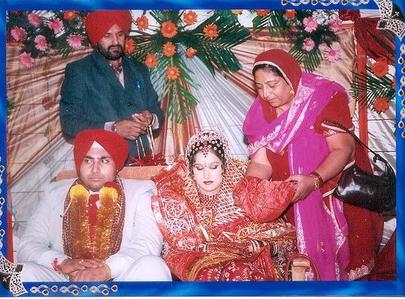
Pawandeep holds a framed photo of her sister. In the photo, Amandeep is wearing a pink salwar-kameez, a Punjabi dress. “She dreamed of a better life for herself and her family. All she wanted was to live happily with her husband and son like any other woman.”
I don’t even know where to begin with this story. The grisly facts of Amandeep Kaur Dhillon’s murder and her father-in-law’s arrest have been covered before, but this weekend, the Toronto Star’s Raveena Aulakh wrote a detailed story. You can read the full article here and it will break your heart, not just because of Amandeep Kaur’s tragic story, but because her story is all too common in our community.
Baldev Mutta knows the stories of immigrant women all too well.
The executive director of the Punjabi Community Health Centre in Brampton says hundreds of young Punjabi brides arrive in Canada every year. Many have arranged marriages. “They don’t know anyone, don’t have any support system and battle pressures most people can’t even imagine exist,” he said.
In the Punjabi culture, men are raised to be dominant while women are expected to be subservient. “The level of thinking of men in the Punjabi community leaves a lot to be desired,” said Mutta, a Punjabi himself. Mutta, who runs programs at four Sikh temples in Brampton, Rexdale, Malton and Oakville, and hosts a radio show, wishes he had been able to reach Amandeep.
Some women are so isolated that they are not allowed to have any communication even with their parents, said Kripa Sekhar, executive director of the South Asian Women’s Centre on Lansdowne Ave. in Toronto. “There are times when we get emails or phone calls from a woman’s family saying they haven’t heard from her ever since she came to Canada, can we check on her,” says Sekhar.In some cases women, bruised and beaten, have been locked up in their homes, not allowed to make or receive any calls. “It’s a problem women face everywhere, but what is unique among South Asians is that we don’t acknowledge it or want to talk about it.”
We can deny it all we want but here’s the sad reality for many (not all) Punjabi families:
(more…)
Just when you think that everything is hunky-dory for Sikhs in Canada, you hear of an incident like this that makes your cringe. Here’s a first-hand account of an incident that took place at the Toronto Raptors game last Friday night.
My brother, Gagandeep Singh Saluja and I, Simran Kaur Saluja attended a Raptors game at the Air Canada Centre on the night of Friday, January 30, 2009. I witnessed something which disturbed me tremendously. After a great night of getting two of the Raptors’ players to sign our jerseys and getting Jermaine O’Neal’s wristband, my brother and I make our way out to see the post-game show.
He tells me he has to use the washroom. Entering a public washroom is not unlawful in any way. I witnessed many people entering and exiting the same washroom my brother wished to use. A security guard approached my brother, out of all people as he is a visible minority that stands out. The security guard told my brother to get out. For what reason? Well, let me describe my brother to you all. He is a third-year student studying Business Management at UTSC and a proud Sikh youth who wears his turban with pride and joy…A huge Raptors’ fan as well. Gagan asks him “for what” while he tries to make his way to a stall and the security guard starts pushing him and saying “You don’t want to start with me!” He then calls back-up. Gagan finds himself with 4 to 5 security guards on him trying to kick him out. Police officers get involved during this time and start tackling him.
I sensed something wrong while I was standing outside watching the post-game show. I was hesitant in terms of if I should check on my brother in the washroom but I thought it wouldn’t be appropriate for me to do that. I decided to wait for him as I thought that the security guard had let him use the washroom. I wait for about 10 minutes for my brother…I was getting a bit edgy and started looking around for him. I had not seen anything.
Later, the security guard is out of breath and sweaty and attends to the location where I had seen him prior to the whole washroom catastrophe. I ask him “Aren’t you the one who was in the washroom?” He said “yeah.” He knew that I was there waiting for Gagan and after another 10 minutes he tells me, “You might want to make your way out as to whoever you were with is being arrested.” I race outside to find my brother without his turban on, in pain and suffering. When I saw his face…I don’t know how to explain such regret. I keep thinking to myself ‘had I gone into the washroom?! Maybe, just maybe they would not have used such force against him.’ I love my brother a whole lot and I never want to see him hurt. This whole ordeal that happened in Toronto, Canada out of all places is just sad.
Today’s Toronto Star has another article on the sad but all too frequent cases of immigration fraud. In this case, a Sikh family was swindled out of tens of thousands of dollars but a crook that promised the son a $450 a week job as a cook in a Toronto hotel.
One morning in February 2007, Harvinder Singh read an ad in a local newspaper that promised to change his life.
The ad offered a visa to Canada and a $450-a-week job as a kitchen helper at a Crowne Plaza hotel in Toronto. Singh answered the ad, and agreed to pay an immigration consultant a $12,500 advance and an equal amount when his immigration documents were prepared.
Today, however, Singh, 31, is still working for his father in this blue-collar city in the northern Punjab region, manning the family photo shop and tending 1.2 hectares of wheat fields on the outskirts of town.
Police say the rise of unregulated immigration consultants is the most troubling crime trend in the state, ahead of a burgeoning drug problem and sectarian violence.
The details of the case are absurd enough to make one laugh if it wasn’t so tragic.

A Sikh gentleman has been involved in a Ontario Human Rights Tribunal matter relating to alleged discrimination against him for wearing a turban at work.
The case centers around treatment that this gentleman received at the hands of a Home Depot employee while posted by a third party security company to provide security detail for a Home Depot construction site. What is particularly disturbing about the allegations are the allegations of racial bias as the employee is alleged to have refused entry to Mr. Deepinder Singh Loomba but also to have stated that he had been successful in the past in not allowing any turbaned persons to work at his site.
Mr. Loomba is a well educated professional who has worked with international companies in other countries and had recently immigrated to Canada, working in security while he was getting settled here. He has decided to take up this case on account of what he saw as a racial bias and a refusal by a large retailer like Home Depot to recognize and deal with the bias. Mr. Loomba has been supported by the Ontario Gurudwara Committee and now needs your moral support.
After over a year of legal haggling he has his day in court and will be in hearings today and tomorrow at the Human Rights Tribunal of Ontario (located at 655 Bay St., 14th Floor, Toronto). The hearings started on Monday and will continue until Wednesday (three days) from 9.30 to 4:30 each day and are open to the public. Moral support and awareness would be appreciated – all the press we can get would also help to put some pressure on Home Depot to do the right thing.
All along Mr. Loomba has insisted that this outcome include an apology to the community and an acknowledgment by Home Depot that they need to implement more racial awareness and sensitivity training in the company. He has stuck this out for the good of the community and it would be great if people could show support and help him out at this crucial time in his case”
It’s been a long time coming but Sikhs all across the globe seem to be making more of an effort to celebrate Lohri today, not only for their sons but also for their daughters. In Tarn Taran, Punjab, this year’s Lohri’s celebrations were dedicated to the 101 baby girls who live in the area.
“The main purpose of this celebration is to make people aware of the social evil of female foeticide. The male and female ratio is getting unbalanced with each passing day. In order to balance the gap in the Sikh society, Akal Takht has given order not to support female infanticide. Female foeticide is as bad as slaughtering a holy cow,” said Parvinder Singh. Chairman, Kalpana Chawla Pragtisheel Society.
::
Also in the news today is the story of Lak[h]winder Singh, a Giani in Kelowna, Canada who was arrested and is being charged for sexual exploitation, sexual interference, two counts of sexual assault and one count of assault. The allegations that give rise to the sexual offences began in late 2007 and the victim is now 16 years old.
Lakwinder Singh, the 29-year-old preacher at a Rutland temple, Gurdwara Guru Amandas Darbar, was arrested after a family with ties to the temple brought forward allegations of sexual impropriety to police last week.
Tarsem Singh, a spokesman for the Gurdwara, said Lakwinder Singh was employed at their temple for nearly seven years, but has since been fired. In addition, the gurdwara is supporting the police’s efforts in finding any other possible victims.
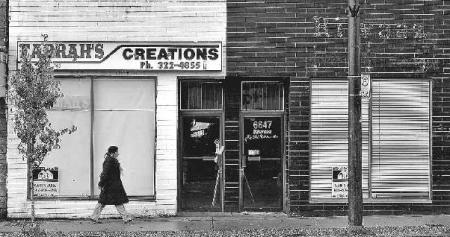 This holiday season I noticed the pinched expressions on people’s faces, the emptier stores, the going out of business sales, and the general air of unease and uncertainty as we round out of the holiday season and into a worsening (economically) new year.
This holiday season I noticed the pinched expressions on people’s faces, the emptier stores, the going out of business sales, and the general air of unease and uncertainty as we round out of the holiday season and into a worsening (economically) new year.
Over the past few weeks, the NYT has been covering how the recession has impacted small businesses, which tend to operate under situations that make them more sensitive to the need for liquidity than larger corporations.
Even companies…, whose products and services are in demand, are being ensnared in the deepening recession…
Some 60 to 80 percent of new jobs [in the U.S.] come from small businesses, Mr. Keating said, and more than 50 percent of private sector gross domestic product is created by small business. [link]
The damage, however, is not just localized. As the slowdown in the U.S. economy drags other world economies down, slow times have also impacted small business owners in immigrant communities, including Vancouver’s Punjabi Market:
“I don’t see much of a future here,” said Virani, who is considering closing her shop.She isn’t alone. At least 10 storefronts between 48th and 51st avenues are papered over and displaying For Rent signs.
I like to spend winter catching up on all the reading I’ve left by the wayside, but imagine my surprise when I came across these op-eds. The first argues that the Sikh youth slate (an all amritdhari slate) that won in Surrey is “fundamentalist,” while the other article argues that Sehajdari Sikhs are, by definition, not Sikhs at all.
Both of these op-eds are a little insane to me. The first argues that the Surrey gurdwara’s prior practice of allowing uncovered heads, shoes, and tables/chairs in the langar hall somehow constituted a “moderated” practice of Sikhi, and it effectively calls for a stand against the amritdhari youth slate, which it maligns as fundamentalist, orthodox, rigid, etc. The second article argues that there is no room in Sikhi for Sehajdari individuals, and then proceeds to trace the history of in/exclusion of non-kesdari Sikhs in SGPC elections.
In my last post, I argued that terrorists, by their actions, sever any legitimate relationship with a religion and any recognized sovereign, and as such terrorists should be identified as terrorists (e.g., “terrorists have invoked an interpretation of Islam to justify their actions”), even if the terrorists use religion or a disputed regional policy as a justification for their acts. Note that the focus of the proposition is identification of terrorists, and that its purpose was to suggest ways in which a backlash against all Muslims in India could be avoided.
This post generated a significant and spirited reaction. For example, some contended that my argument was typical of the left, of apologists, and of those who fail to understand the demonstrated link between Islam and terrorism. In response, and consistent with the fact that it’s exam time in classrooms and campuses across America, I ask the following:
Who made these statements:
“Ours is a war not against a religion, not against the Muslim faith. But ours is a war against individuals who absolutely hate what America stands for[.]”
“Americans understand we fight not a religion; ours is not a campaign against the Muslim faith. Ours is a campaign against evil.”
“The enemy of America is not our many Muslim friends; it is not our many Arab friends. Our enemy is a radical network of terrorists[.]”
“[T]he war against terrorism is not a war against Muslims, nor is it a war against Arabs. It’s a war against evil people who conduct crimes against innocent people.”
And the kicker:
This enemy tries to hide behind a peaceful faith. But those who celebrate the murder of innocent men, women and children have no religion, have no conscience and have no mercy.
I know that we Punjabis love importing our culture and traditions to the countries we now call home, but this is getting ridiculous.
Brampton city councillor Vicky Dhillon is on a crusade to stop stores in his area from selling two kinds of decorative poppy flowers, which he said contain addictive opium.
Dhillon said the flowers and stalks are ground into a brownish powder — called doda — that is openly sold for about $10 for 10 grams at about eight meat stores in his Wards 9 and 10. The powder gets a person high when mixed with water and ingested, he said. “This drug is causing a lot of problems in the community,” said the councillor, adding it’s largely used in the Sikh and Hindu communities. His ridings contain more than 100,000 Sikhs.
Dhillon said he’s concerned the use of doda will spread to area schools due to its low cost. Peel Regional Police raided several businesses two weeks ago that were allegedly selling the drug. One man was arrested and 38 kilos of doda seized. Dhillon said he’s raised his concerns with Peel and Brampton city councils and health officials are looking into the problem.
Several varieties of poppies are allowed into Canada as decorative flowers, but only a few have a high opium content. Dhillon is calling for a ban on sales of two specific poppies — Arizona and Holland. “In the last two years, the use of doda has exploded,” he said yesterday. “This is a big threat to the younger people in our community.” Some of the stores selling the “ornamental flowers” were conducting brisk business yesterday. (Link)
I guess I should not be surprised. If drug use is at epidemic levels in Punjab, its naïve to assume people are going to magically clean up their act when the come to Canada. In fact, the culture shock, isolation and life changes that usually come with immigration, probably only make existing drug dependencies worse.
I was always amazed by the number of “meat shops” in Punjabi communities across Canada. I didn’t think there was enough demand for specialized Punjabi meat products to justify the supply. What I hadn’t taken into account was the “premium products” offered at the back of the store.
As a young kid, the langar hall was my favourite space in our local Gurdwara. Located in the basement of the building, it was a home away from home. My parents helped build the Gurdwara in the 1970s and I spent many weekends helping with the preparation of Sunday morning langar. I occasionally helped with the cooking, often with the serving and always with the running around. The wide open empty space in the hall provided many hours of fun with playing tag and football with a ball made of tied-up ramaals (handkerchiefs). It was a place to hang out with kids that looked like me and who were going through the same things as me.
As I moved through my late-teens and what I affectionately call my “hard-core” phase, I saw the langar hall as a place serving only two specific functions; serving meals and eating meals (on the floor). Idle social conversation wasn’t what you were going to Gurdwara for. You could do that during the famous multi-family dinner parties that all Punjabi parents dragged their kids to. Gurdwaras were for serious matters and all these people sitting around and gossiping were just taking up valuable time space. Thankfully, I lightened up.
Fast forward a decade (or two) and now, I’ve reconciled my past. Growing up, while I was hanging with other kids who called “jooda time-outs”, the adults were also drinking chaa, talking and sharing stories with other adults. Through the universal acts of serving a meal and sharing a meal, the langar hall became a hub for my local Sikh community.
I’ve seen many an animated conversation in a langar hall. I’ve seen people talk with passion about faith, family, politics, business, sports. In fact, aside from the langar hall, our community has few other forums that provide for all walks of life to come together and share their ideas.
That is why I love that the Langar Hall has gone online. In the same spirit of my community Gurdwara, this site brings together ordinary Sikhs to talk about the issues of the day. The only difference here is that you have to supply your own chaa and mutheai (how the heck do you write that in English? Its worse than paranthas).
I’ve been asked to take on the seva of contributing to this great project. I do not have an English degree from a fancy American university like my illustrious colleagues, in fact I probably should have taken up my Grade One teacher’s offer of English as a Second Language classes. Regardless, I will promise to add another voice to the conversation. Not one that is highly educated or representative of all Sikh-Canadians but one of a second generation Sikh-Canadian born and raised in a country he loves as his own.
Let the gup-shup begin!
I was waiting until after the election to write this post as I didn’t want my personal thoughts to be in anyway seen as promotion or endorsement.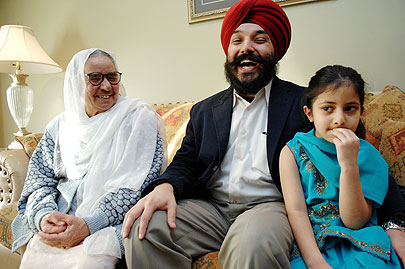
I have been a fan of Navdeep Singh Bains for many years now. I still remember his victory into the Canadian parliament as the first Amritdhari Sikh 4 years ago and I believe the youngest elected Liberal MP (26 years old) at that time. My respect for him grew, in what I believe, was his principled opposition to an overstretching then-Jathedar Vedanti on the issue of same-sex marriages.
Vedanti said he was dismayed that one MP, Ontario Liberal rookie Navdeep Bains, argued against him, but said the others listened respectfully.
“The Sikh religion would never accept such MPs,” said Vedanti. “Nobody would support such a person having such dirty thoughts in their mind because it is against the Sikh religion and the Sikh code of conduct and totally against the laws of nature.” [link]
Well many Sikhs as well as many others Canadians in the Mississauga-Brampton South riding, continue to support and ‘accept’ Navdeep. Just this month he successfully won his third term. (Vedanti on the other hand has come and gone [I have noted my criticism of the present Jathedar-obsession in a previous post])
In an effort to better understand the food habitats of Panjabi immigrants, Canadian researchers conducted a three-year study on the ingredients used in daily Panjabi meals and food choices made by Panjabi families.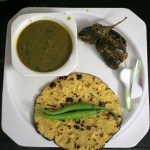
Gwen Chapman, study leader and British Columbia University nutrition professor, stated:
“Since cardiovascular diseases and type II diabetes are more prevalent among Indians and they are linked to food habits, we wanted to understand what ingredients went into daily Punjabi or Indian meals.”
An important part of study was also understanding how cultural affiliations play a role in Panjabi immigrant food choices.
Researchers found that “in Punjabi families in British Columbia … separate meals are often prepared to accommodate elders who need traditional roti, daal and subji, and younger family members who prefer to balance Indian and “Canadian” foods.”
While reading this article I thought about how these food choices actually play out in immigrant Panjabi homes across North America. I remember the rotis without butter for those who have high cholesterol and the weekend meal of burger and fries for us “American” kids. There were also the interesting “masalaa” pastas, lasagnas, and pizzas that had a “Panjabi” twist (i.e. tons of garam-masalaa). I recall uncles’ refusing to eat “kaa-foos” prepared by their wives, aunties making tofu-sabiji, and mothers’ substituting olive oil for vegetable oil when making tarkas. Many of these food choices were an effort to provide more healthy meals as a “preventive” form of action against heart disease and diabetes; while others were made to satisfy taste-buds.
So I was wondering what interesting food choices have you seen Panjabi families make in the Diaspora both to satisfy taste-buds and become more healthy?
As part of its series on the upcoming federal elections in Canada, the Globe and Mail offers this article on the emergence and success of Sikhs in the Canadian political scene. Consider:
- Sikhs [are] the only group with a greater number of MPs than their share of the population.
- [In the House of Commons,] Punjabi is now the fourth most common language, after English, French and Italian.
- Many Sikh candidates live in Mississauga and Brampton, where they comprise 15 per cent and 19 per cent of the population respectively.
- [There are] 17 Punjabi newspapers in Brampton [Link]
These statistics are very impressive. I applaud the Sikh candidates for their participation in Canadian politics (which cuts against the suggestion that Sikhs are not sufficiently integrating into Canadian society). And I thank this publication for highlighting the political advancements that Sikhs are making in Canada.
That said, I am troubled by two parts of the article:
Earlier today I stumbled on this article in the Montreal Gazette detailing the suspension, and now calls for a speedy trial, for a Sikh boy accused of assault:
The teenager made his first appearance on the charges in Montreal Youth Court yesterday where he pleaded not guilty to three counts alleging he used a kirpan, a Sikh religious object that resembles a dagger, to threaten his schoolmates.
This case comes on the heels of another landmark Quebec case in which Canada’s Supreme Court unanimously voted to protect the right of Sikh school children to wear the kirpan (with some limitations on its use) in 2006.
But did the boy actually draw, or use, his kirpan during the argument? At first blush, it sounds like this was a schoolyard disagreement, but if the boy drew his kirpan it would be incredibly inappropriate, both under dharmic understandings and under school policy. But on reinspection, it’s unclear if this incident actually ever happened, or if this is a racist reaction against the kirpan. The boy’s lawyer, the same man who argued the Supreme Court case for accommodation of the kirpan, believes the reaction is racist:
Grey accused the Montreal police and the Marguerite Bourgeoys school board of “overreacting.” He also said a large part of Quebec society has never accepted the Supreme Court’s decision.
“I think that what we’re witnessing – it’s my opinion and the court will decide – is a deep bias against the kirpan that has never died in Quebec…”
If his lawyer is correct, then this brings up a larger issue: how do inclusion policies and values translate on the ground if a region or group is hostile to accommodation?
Legal protection of the kirpan is vitally important and relevant and worth protecting, but, if this incident did not take place, how many Sikh children will be pressured, harassed, and suspended from schools for exercising their right to practce their faith? In this case, the school board is not an advocate for the Sikh child (and in the previous kirpan case, when the school drafted an accommodation policy it was invalidated by the school board as well); if that democratic channel fails, then how can we support families in this position?
Heads-up friends, the season of the “Spinning Wheel Festival” is about to begin across North America this autumn. Celebrating Sikh films and art, the first stop will be in New York City on Saturday, October 04, 2008 at the Asia Society & Museum (p.s. that’s next Saturday). Buy your tickets NOW! The wonderful Rabbi Shergill will be performing at the opening gala (yes I am really biased here … I heart Rabbi Shergill) and DJ Rekha will be literally “spinning” at the after party.
Films a the NYC festival will range from documentaries on Pahelwani (i.e. Panjabi wrestling) and Kaba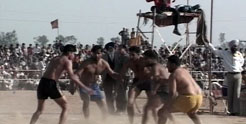 ddi-playing Canadian police officers to issues affecting the Sikh community from 1984 and post-9/11 hate crimes. There will also be short and feature films. For example, one on a young boy’
ddi-playing Canadian police officers to issues affecting the Sikh community from 1984 and post-9/11 hate crimes. There will also be short and feature films. For example, one on a young boy’ s struggle to keep his hair while his family fears the obstacles he will encounter and another on “… a young Sikh doctor struggling with the inequities of the American Health System and ultimately his own identity”. The Holy Duels of Hola Mohalla is a film looking at the Khalsa Panth.
s struggle to keep his hair while his family fears the obstacles he will encounter and another on “… a young Sikh doctor struggling with the inequities of the American Health System and ultimately his own identity”. The Holy Duels of Hola Mohalla is a film looking at the Khalsa Panth.
The films seem interesting both in content and presentation. The stories are grounded in the realities many of us encounter everyday. You can get a full listing of the films and their synopses here.
In the past, I have attended the “Spinning Wheel Festival” at one of its many North American stops and found it a great space for artists and art-enthusiasts to be exposed to Sikh creativity. I remember there being a panel discussion with the directors and the audience. We don’t have too many of these creative opportunities in our community even though we spend plenty of time and space advertising foreign medical schools in Poland, China, and the Caribbean.
I have found that some films are really hit or miss at these festivals, but it’s expected sense the focus is on cultivating and inspiring creativity; while, building a permanent Sikh film festival for years to come. Cash prizes are awarded to the “bests” in various categories. I have been told that the listing and quality of films varies across the different North American stops.
At the end of the day why not go, especially if it’s close by. I personally think it’s worth a visit as an act of supporting Sikh arts and learning about the various issues affecting our community. Sometimes we get too caught up in our own worlds and don’t realize these issues are taking place or we are in amidst of them and they become normal parts of our lives leaving very little room for reflection or exposure to others’ perceptions. Thus, it’s an 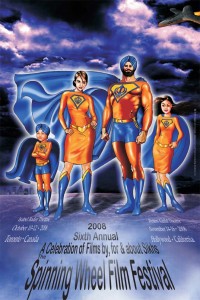 opportunity to get a fresh/new look at various issues.
opportunity to get a fresh/new look at various issues.
Lastly, the arts, from painting and photography to films and music, are our community’s soul! They help us speak in ways we can’t always articulate. So go save your soul and attend a Sikh artistic event! 
Okay, enough of the attempt at convincing … the other North American stops will be:
- Toronto, Canada from October 10-12, 2008 at the Isabel Bader Theatre.
- Hollywood, California from November 14-16, 2008 at the Writers Guild Theatre.
Are ya’ll thinking of going? What have your experiences been at the various Spinning Wheel Festivals? Does anyone know of other North American stops?
p.p.s. The Toronto and Hollywood poster is really interesting isn’t it … a conversation in of itself!
So recently I came across a blog about all the “Stuff Korean Moms Like”. A Korean girl, Chiyo, who loves her KM (Korean Mom) decided to create this blog “to share the joy and dread of KM”. As I went through the list … I kept thinking about our own PSM’s (Panjabi Sikh Moms) … now now don’t think it’s funny to call our mummies’ PMS that actually stands for Panjabi Male Syndrome!
As I went through the list … I kept thinking about our own PSM’s (Panjabi Sikh Moms) … now now don’t think it’s funny to call our mummies’ PMS that actually stands for Panjabi Male Syndrome!
From corningware to marrying people off and stank eye … I found many similarities between KMs and PSMs (although the differences were stark … I don’t even think many PSMs know what redbean is let alone love it. And when it comes to Jesus … let’s just stick with the Gurus and Waheguruji)!
Inspired by Chiyo’s blog on Korean Moms, let’ start our own list of “Stuff Panjabi Sikh Moms’ Like”! I will begin …
- Tupperware (i.e. I am not just talkin’ about Rubbermaid … I mean sour cream and whipped butter dabhaa). Over time this Tupperware becomes yellow from all the haldhee in sabjis … but soak it in the sun and most of the stains go away. Slowly over time old ones are replaced as new ones are collected.
- Corningware (do I really need say anything more … I think Chiyo’s explanation resonates perfectly with PSMs).
- Zee TV, Sony TV, and Alpha Etc. Punjabi nateekhs (what’s your mom’s favorite soap opera …).
- Noon Dhani (i.e. the steel container with small steel bowls and spoons for all their spices).
- Dhahee (i.e. homemade yogurt … sorry I personally can’t stand the boxed stuff after growing up on my mom’s delicious freshly made dhahee).
- Outrage at the rising cost of Ataa (i.e. flour that is commonly bought at the Indian store to make roti).
- House-walls that are painted hospital white … look how clean and simple they look. The rooms feel much more lighted with this color.
- Overstuffing Family And Friends With Food … lai if they leave your house without a food-coma, they did not have a good-time.
- Cooking your favorite Panjabi dish when you come home from college. It’s a sign of how much she missed you.
- The ten Gurus’ pictures, particularly those of Guru Nanak Dev Ji and Guru Gobind Singh Ji, are the number one home-decorating items.
Please add to the list ( it’s in no particular order)! What do you think Panjabi Sikh Mom’s really like? I know many of you must have your own favorites! 
Disclaimer: Please keep it clean, respectful, and hate-free … I really should not have to say this, but unfortunately in the virtual world people often display a “holds-no-bar” attitude when commenting on issues like this one.
This past week, I saw this advertisement about the “GurSikh Speed Meeting.” For those of you who have no idea the Sikhnet’s Gursikh Speed Meeting is obviously (and admittedly) the Sikh version of speed dating. According to the organizers of the program: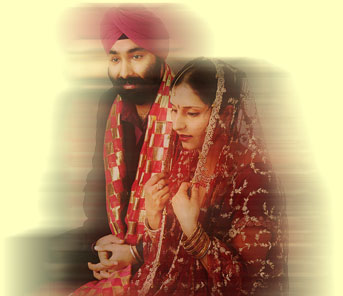
The concept is quite simple. An equal number of Sardars and Sardarnis register. On the event date, each Sardar will meet each Sardarni one-on-one and chat for a specified number of minutes rotating till they have met all the Singhnis. This face to face style of meeting has spurred much interest, in addition to, respecting the participant’s privacy. Only if there is an agreed ‘CLICK’ will an exchange of contact information occur.
I remember when I first saw Sikhnet advertising this a couple of years ago and thinking to myself, “this is bold.” I don’t necessarily think dating for Sikhs is anti-gurmat, but dating is definitely still taboo in A LOT of Punjabi Sikh families.
While the young Sikh filmmakers are probably preparing for the annual Sikhnet Youth Film Festival (have you seen their ad on satellite television, it is very impressive!), I recently came across some internet announcements for a list of fascinating Canadian-produced short films that I hope will galvanize future discussions.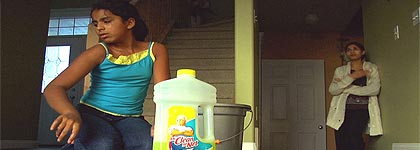
Although I must confess, at this point, I have NOT seen any of them, still, I wanted to highlight them and hear back from the Langa(r)eaders about their thoughts. Hopefully some of our more vocal Canadian Langa(r)eaders will give us first voice about the films: P.Singh, yes even kaptaan, and others.
Me, Masi, and Mr. Clean
The description from the film’s website is quite poignant:
Eleven year old Seema has issues with her skin colour. Surrounded by the white kids of her community, and inundated by her masi’s (aunt) opinion that fair skin is better, Seema resorts to drastic measures to bleach her skin.
Seema mistakenly believed that using Mr. Clean on her skin will lead to a fairer, more beautiful colour. When Seema ends up in the hospital an unsuspecting character helps her understand skin colour isn’t what defines the person – it’s what’s beneath that counts[link]

